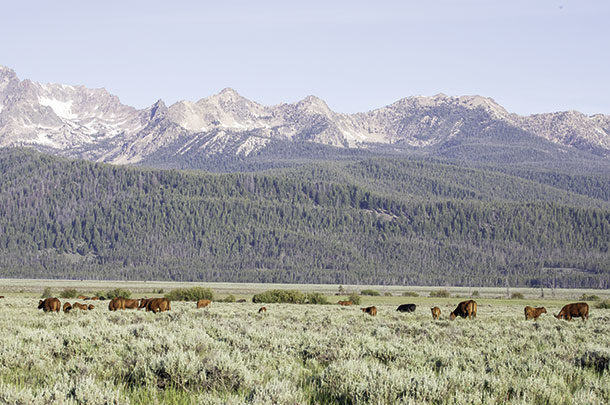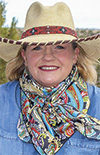Do you ever go to the pantry or the refrigerator and open it up wondering what you will fix for supper? Or maybe you’re at the store and cannot remember what the heck is in the pantry. Do you have what you need to prepare the next meal?
Your cattle are doing the same thing, but like your kids, they count on you to keep the pantry stocked with the things they love.
Do you know what is in your grazing pantry? Can you tell me your forage production? How about how much forage your livestock need daily or even annually? These are important things to know in the ranching business. While we can somewhat influence what is in the pantry, we cannot run to the store when supplies get low.
The proper name for what we are going to talk about here is animal demand or forage balance. Grazing is more than just putting up a bunch of fences and rotating animals around. Or even turning them out into a large pasture where you plan to gather them months from now. How do you know if there is enough out there? How much is enough?
Too many people jump off into rotational grazing without doing the inventory of the “pantry” first. I do not care how many pastures you have or how often you move, you must match forage supply with animal demand. Your grazing scheme may well facilitate increased forage production, which may lead to the ability to graze more animals, but you must know how many groceries you have in the pantry to avoid damaging rangeland or pasture.
In my last article, which appeared in the July issue, I stressed the need to know your forages. Some are good, some are not-so-good, and some will not be grazed until cattle are desperate for feed – which is never a good situation to find yourself.
Taking inventory of your “pantry”
Clipping
It sounds awful. You are on your hands and knees, clipping the forage off a plot. I use a 0.25 meter squared, three-sided rebar frame. A four-sided one will bust, so just use a three-sided one. If the forage has moisture, you’ll want to put it in a paper bag and let it dry out before you weigh it. Toss the bags somewhere warm and they will dry in a day or two. Or if you are motivated, you could dry them in a very low-temperature oven.
Weighing
Hang with me here, graziers. You need a scale like the one pictured in Photo 1.

A 300-gram scale (pictured) and a pair of Corona clippers are essential to know what you have in the pantry for your cattle. Photo provided by Jenny Pluhar.
They are $50 to $60 from an outfit like Forestry Supply. I like a 300-gram scale. If you are lucky enough to have lots of forage, it might take a couple of bags. That scale and a pair of Corona clippers are absolutely essential to know what you have in the pantry for your cattle.
Calculating
Weigh the dry forage in grams. Thanks to the global nature of range science, we do these things in metric measurements. Your forage weight in grams multiplied by 10.7 gives you pounds per acre. Whew, let’s get back to English!
I can inventory 10,000 acres in a day utilizing this method. Then comes some time at the desk with a calculator. (Remember when the teacher made us learn to do all the math long hand because, “You won’t always have a calculator handy”? Math is not my strong suit, and I am awfully glad that teacher was dead wrong with that prediction.)
Analyzing
OK, now you have your forage totals. You probably need to realistically look at your data and make some adjustments. You know by now those cattle do not eat all the forage with equal gusto. I usually take out the western ragweed, yucca and sand sagebrush plots and a portion of the sand dropseed and threeawn plots. Now we have what forage is available to your cattle.
An important side note:
Harvest efficiency is about 25%. Some grazing schemes will allow you to get better harvest efficiency as your grazing skills improve, but for most, it is approximately 25%. You need to leave some cover on the soil and some grass biomass to allow the plants to regenerate, strengthen their roots and be able to grow robustly the following year. That’s where the old “take half, leave half” rule comes into play. Now, of the half you are taking, much is lost to waste. They lay in it, defecate and urinate on it, wildlife eats their fill; that all comes to roughly half of the half you took. So you are left with a 25% harvest efficiency.
How many cattle can your pantry feed?
First off, do you know how much your cows need to eat daily? A 1,000-pound cow with a calf at her side is 1 animal unit (AU). Your cow probably weighs at least 1,200 pounds, often more. She is 1.2, 1.3, or 1.4 AUs, depending upon her size. Stockers are a portion of 1 AU until they reach 1,000 pounds. A bull averages 1.5 AUs. Each AU (1,000 pounds of beef cow) needs approximately 3% of her bodyweight in dry matter daily. That’s 26 to 30 pounds of dry grass. For 365 days, that AU needs between 9,490 and 10,950 pounds of dry matter forage.
Now you know where I am going with this. You’ve generated a number representing available forage, and now you know your herd demand. That is the magic formula to figuring out the carrying capacity of your range or pastureland. You will also be able to determine if you need to feed hay or if you can support them yearlong on the forage you grow. These animal demand numbers will tell you how much hay you need to feed daily. You can also analyze if you would be better off with less cattle and utilizing more grazing and less hay.
Accounting for geographical differences
If your ranch is in semiarid country, it might take 35 acres to support an AU for an entire year. In the desert, carrying capacity is often referred to as AU per section, while in more productive coastal or midwestern rangelands, it is AU per acre.
An important thing to remember is do not go by some “county stocking rate” you heard at the coffee shop or from the real estate agent who sold you the place. Or even what your grandpa always said the ranch would support. There is no such thing. There is no substitute to doing your own inventory.
These two pictures in Photo 2 are only 30 feet apart, with the same kind of range site.

These two pictures are only 30 feet apart – one is incredibly productive and the other is not. Matching forage supply with animal demand is critical to maintaining a good stockpile of forage and avoiding damage to pasture or rangeland. Photo provided by Jenny Pluhar.
One is incredibly productive and palatable big bluestem, producing thousands of pounds per acre. The other, on the other side of the fence, is also palatable, but is buffalograss that has been stocked too heavily and struggles to produce 300 pounds per acre. Obviously, those two pantries can support very different amounts of cattle.
Cattlemen take great pride in the weaning weight of their calves. I believe they ought to take as much pride in knowing their forage production. As I say all the time, grazing management is not rocket science; it’s much tougher. But with that fancy phone calculator and a few tools, you can get to know what’s in your pantry fairly easily.











